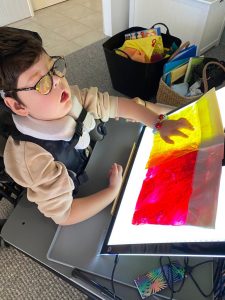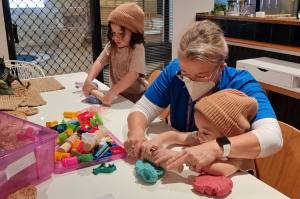Written by Hannah’s House Play Specialist Sue Desmond
Play is a fundamental part of a child’s learning. Play teaches children how to interact with their environment, solve problems, learn new motor skills, and acquire language. For many of our children how we go about play may look a little different due to their disabilities, but it doesn’t make it any less important.
Did you know that play mimics communication?
Simply by playing with your child you are teaching them about communication. A great way to build language skills is to just sit with your child and actively engage in play with them.
When we play with a child there is a routine which involves engaging in a back-and-forth exchange, just like in a conversation. For example, rolling a ball or toy car back and forth, or a hand over hand manipulation of an object, requires two people to complete the task just like in communication. In communication when one person talks, the other responds, whether verbally or through their body language.
Play also helps children learn cause and effect relationships. Two examples of cause-and-effect comprehension developed through play are:
- Blocks: blocks can stack, but if you push them over, they will fall or
- If you flick a switch a light will come on, or perhaps a toy will move or make a sound.
Cause and effect comprehension is another important way that children increase their communication skills. When a child begins to use new words for communicative purposes, this is essentially a cause-and-effect relationship: the child says a word, and then gets what they requested in return. For our children this may look a little different. When I raise my eyes to a yes no question I am agreeing to a statement, or when I move my feet, I’m telling you I’m uncomfortable.

The most important point in all of this is… use their communication device!!
Regardless of the activity you are undertaking always have the child’s communication device close at hand. Even if it’s only you using it. As previously mentioned, incidental learning and learning through modelling are key to children’s development and if you are modelling good communication, they are more likely to use it too.





